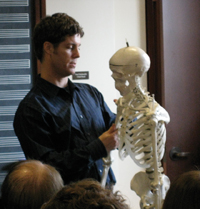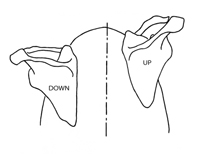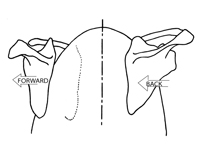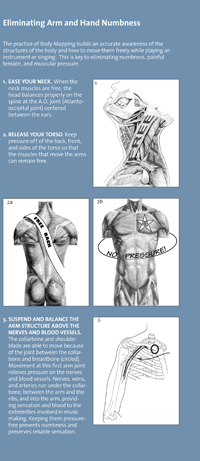Body Mapping for Better Playing
Correcting body maps in the brain can help musicians recover from performance injuries and set them on the course to better music making.
 |
|
| Jerald Harscher teaches body mapping classes using a skeletal model. |
A Quiet Epidemic
Multiple surveys show that a majority of musicians of all ages suffer quietly from pain, injury, and frustrating technical limitations. The New York Times has reported that 40 percent of conservatory students experienced injuries that forced them to stop playing for a time or even to end their careers. Closer to home, a survey conducted by Berklee Professor Neil Olmstead of roughly 400 Berklee-trained musicians revealed that 78 percent of respondents experienced pain, numbness, or discomfort while practicing or performing. Additionally, up to three-quarters of professional musicians have experienced injuries from playing their instruments. Virtually all players of certain instruments will eventually be affected, though guitarists and pianists are among the most often injured.
Some musicians are ashamed to admit that they have a performance-related injury and don't acknowledge their problems. Others maintain the secret to protect their professional reputations. The tendency to keep silent suggests that those affected may suffer from emotional pain alongside physical injury. Many players or singers assume that other musicians don't struggle with performance injuries and play through tension and pain, hoping the problem will simply go away. Many just work harder hoping to become stronger. This heroic approach is a part of our cultural consciousness. After all, it's how the West was won: we pull our shoulders back, stick out our chests, bite our lips, and press on! Unfortunately, the heroic no-pain, no-gain, muscle-through-it approach is at best counterproductive. And at worst, it can lead to far more serious problems.
Musicians most often experience pain and pressure in the muscles and mistakenly assume that the problem is muscular in origin. Some musicians seek solutions that treat the muscles in an isolated manner through physical therapy or gym workouts. Often these conventional approaches only exacerbate the problem.
On a positive note, a growing number of contemporary musicians have become aware that most muscular pressure and tension originate with faulty movement patterns based on "mismappings" in the brain or misconceptions about their own body structure, function, and size. Through a process known as body mapping, these mismappings can be discovered and corrected. When these mental corrections are applied to movement, problems with muscular pressure and tension can be eliminated permanently without physical therapy, medical treatment, or a go-for-the burn workout regimen.
The Scientific Basis for Body Mapping
Everyone has a body map. The scientific explanation of the body map is that it is the internal representation on the cortical surface of our brains that governs all movement-including those required to play an instrument or sing. Our personal body maps tell us about our structure, function, and size.* Cellist William Conable, who is credited with the practical discovery of the body map in his teaching studio, observed that "students move according to how they believe they are structured, not according to how they are actually structured."
|
|
|
 |
|
 |
|
 |
|
| Anatomical illustrations courtesy of Barbara Conable from her book What Every Musician Needs to Know About the Body. Used by permission. |
The body-mapping process starts with gaining a correct understanding of our body's structure. It is worth noting the distinction between a theoretical knowledge of anatomy and the body map. It is not enough simply to have an abstract understanding of anatomy. Changes to the body map occur in part through kinesthesia, or sensory perception in the muscles and connective tissue. This perception enables a person to accurately understand the anatomical structures and functions that enable him to correct his movements. The brain's neuroplasticity, or ability to form new neural connections, enables us to change movement patterns and recover from injuries. This is central to body mapping and to correcting our own body map.
About 15 years ago, as I launched my performing and recording career, I was among the musicians quietly suffering from a performance-related injury and, consequently, limitations in my guitar playing. I went to a musician's medicine clinic in Boston seeking help for unexplained hand weakness and an emerging loss of coordination. After a host of tests, my doctor was unable to give a diagnosis of my condition and sent me to a physical therapist, who prescribed various strengthening exercises. I squeezed putty and lifted dumbbells, but my symptoms got only worse-evidently from the treatment itself. Knowing I was dissatisfied, the physical therapist referred me out of the medical system to a movement educator versed in somatics: the study of human movement. This was the turning point for me.
During our first lesson, the movement teacher indicated that I was not moving my shoulder blades (or scapula). My response was, "You mean my shoulder blades move?" Over the next week I explored the whole range of movements that my shoulder blades could make. [See the shoulder blade motion diagrams.] To my relief and amazement, as my shoulder-blade movement became freer, so did my hand.
Conscious Awareness
My lack of awareness of my shoulder blades pointed to a functional error in my body map of my arm structure. Once I became aware of my misconception, I gradually cultivated free movements of my shoulder blades that were not possible before I became conscious of all the skeletal structures on which the movement of my hands and fingers depend. As a result, I became aware of tensions that I had not noticed before. This new awareness enabled me to release unwanted, counterproductive tension in my arms and hands and my playing became immediately freer and more satisfying. Once I assimilated the new movements into my body map, I no longer needed to consciously think about them. They became a natural part of my movement repertoire.
When the body map is accurate and adequately detailed, our movements feel easy and well coordinated and our music making improves. When the map is slightly off, movement is also off. When the map is way off, movement is inevitably awkward, inefficient, and often produces injuries.
Many naturally free movers are not conscious of how accurate their maps are, but when questioned, they reveal a high level of detail. The opposite is also true. Many tense players are unconscious of their inaccurate and insufficiently detailed maps. Body mapping helps tense players become conscious of misconceptions about their body structure, function, and size and enables them to correct the mapping errors and improve their movements. They can then move in harmony with their body's design as opposed to moving in conflict with it.
As Mark Twain said, "It's not what we don't know that most harms us. It's what we know for sure that just ain't so!" My faulty inner conception that my shoulder blades couldn't move is a mismap readily understood by any somatic educator. It's just one of many common mismappings that harm musicians. During the next few years, I became aware of several other common mismappings that limited my movement and caused strain. Discovering and correcting each of them brought increasingly more muscular freedom and technical facility. Before long I could expand my abilities beyond their previous level.
Through movement training, I fully recovered from problems that even highly competent doctors specializing in music medicine did not understand. My success 15 years ago in recovering from a potentially career-threatening condition ultimately prompted me to acquire rigorous training in anatomy and somatics to become a body-mapping teacher to help other musicians.
 |
|
| The right hand, palm facing upward. The ulna (the darker of the two arm bones) is the axis of forearm rotation. | |
 |
|
| The radius crosses over the ulna when the palm of the hand is turned to face downward. | |
 |
|
| Most musicians are unaware of the actual length and structure of the thumb and that its first joint is located nearest the wrist. |
Medical Versus Movement Problems
Anyone experiencing numbness in the arms or hands while playing should consult a doctor to rule out a medical problem. Most performance injuries, however, are not typically medical problems. This is borne out by the fact that traditional medicine is successful in helping musicians recover only 5 percent of the time. Since musicians most often suffer because of movement issues, it's important to assess whether our problem stems from movement or is a medical one.
I recently worked with a guitarist who experienced numbness in his right hand. He had seen a medical specialist and was in a great deal of distress because the doctor had recommended a surgery to remove his first rib. Instead, we worked to accurately map his arm structure so that his movements included his collarbone and the first arm joint, which is formed between the clavicle (or collarbone) and the sternum (or breastbone). A month later, he was free of numbness and relieved to avoid an invasive surgery. [For more on relieving arm and hand numbness, see "Eliminating Arm and Hand Numbness" on page 33.]
Musicians are particularly vulnerable to pain, injury, and limitation because musical training does not include information about body movement. Incorporating movement training with technique training for students and advanced players alike can eliminate performance injuries.
Musicians Move for a Living
All dancers, actors, and athletes know they move for a living. It's obvious. But some musicians struggle with the idea that their living depends on movement. Still, watching a video of any musician performing with the sound muted readily indicates that musicians indeed move for a living. Since these movements are often refined, precise, and rapid, many musicians may be more concerned with how not to move than with cultivating the most appropriate and effective movement-large or small-to create the desired sound and musical result.
Sometimes musicians believe that, as a matter of efficiency and control, the only body parts that should move in playing an instrument are those that directly touch the instrument. The most accomplished players, however, understand that an integrated, whole-body-awareness is vital for proper technique. I recently interviewed classical guitar phenomenon Jorge Caballero for my Virtuoso's Map Project. When I asked if he moves for a living, he replied, "Absolutely" and had a great deal to say on the matter. He added that if a musician does not believe that he moves for a living, "there are so many things about the music they just won't get." (To view the complete interview segments with Caballero, visit www.thepoisedguitarist.com.)
The critical first step toward trouble-free and satisfying music making is for performers to map themselves as movers. Some do this intuitively. Others, though perhaps equally talented, would benefit from movement training (e.g., body mapping) and movement awareness to access the artistic and technical choices of those who move well.
A Body Mapping Class
When I work with musicians, I observe their movement as I listen to them play. Perhaps a student's pinky finger sticks out and away from the rest of the fingers-appearing more like the thumb than the pinky. At the same time, the thumb may look as if it has been jammed into the strings, keys, bow, etc. Humans are gifted with an opposable thumb, which creates possibilities for a rich variety of movements in opposition to all four fingers. When a student does not move his thumb well, it signals mapping problems. Often thumb difficulties are an indication of mismapped forearm rotation. This mismapping is the cause of much suffering among musicians and is the origin of many tendonitis injuries.
I could simply tell a student what I've observed, but that wouldn't be very helpful. Instead, I stop and ask students to explain the movement involved in turning the hand from a position where the palm faces upward to a downward-facing position. Often the reply is, "I can't explain it, I've never thought about that." I give the student time to think about it as he turns the palm a few times to see whether any consciousness of the movement emerges. The student may say, "I just twist my wrist, and that moves my hand."
We then spend a bit of time talking about what the word twist means to the student, but at this point the mismapping is confirmed. It's apparent from the student's movement, language, and gesture that he feels that this movement of the hand happens as a result of a "twist" at the wrist. Even the choice of the word twist as opposed to move or rotate reflects the strain that the student experiences in this simple act.
My students review the classroom skeletal model, anatomical images, and video animations.** These materials help students to see and understand that the hand is turned by the movement of the radius: one of the two bones of the forearm (see figure 1).
I demonstrate how this movement of the radius occurs at the elbow, very far from the wrist where students may believe that the movement originates. Once we discover that it is not the wrist that "twists" but the hand that is carried by the rotation of the radius starting at the elbow, we have an aha moment.
**To see list of resources including slides, DVD and video animations, and books used in Harscher's teaching, visit http://thepoisedguitarist.com.
I frequently do a couple of movement explorations with students where they can "try on" the experience of this new, accurate map. As they move the hand, they touch the ulna, the other bone in the forearm, noting that the ulna is stable and does not move as the radius crosses from its previous position when the palm faced upward (see figure 2). I also note that the ulna is the axis of rotation on the pinky side of the arm. I've also found students who have incorrectly mapped or believed there was only one bone in the forearm. They are particularly difficult to train until this mismapping is corrected.
Invariably students remark that they feel a sense of ease with the new movement versus the strained hand and finger postures caused by their previous misconceptions. A student understands and feels the motion of the radius carrying the hand as it rotates around the stationary ulna. Instead of being on track for tendonitis because of a mismapped forearm rotation, the student avoids injury and experiences new capability in playing. Over time and with follow-up, the new ease of movement can be fully assimilated into playing.
Click to view |
Body Mapping: Foundation for Healthy Technique
At every stage of a musician's career, correcting a mismapping eliminates tensions that place limits on playing. From the beginning of training and throughout a student's developmental stages, body mapping fortifies the foundational aspects of technique. For instance, the training of basic finger and thumb movements relies on an accurate map of finger and thumb joints. Since joint movement is an integral part of instrumental technique, a player must know precisely where the joints are and have all these joints included in his body map.
Many musicians, for example, are completely unaware that the thumb has three, not two, joints (see figure 3). Missing from many musicians' map is the joint nearest the wrist. Attempting to train the thumb using only two joints is difficult and inevitably results in muscular tension that affects tone and the fine motor coordination required for accuracy. Since many musicians move their hands for a living, mapping all the joints in their true locations is a priority from the outset. Establishing an accurate body map of joints early on makes the work of teacher and student more rewarding and successful.
Refining the body map facilitates improvement in technical areas such as developing speed and breath support. Singers and players of wind instruments need to map all the structures that move during breathing to ensure that common breathing mismappings don't limit them. Interpretive elements such as tone production, variance of timbre, dynamic shaping, voicing, and expressive grouping all depend on nuanced movements. All are made accessible to the player through refining the body map.
An athlete or dancer expects to retire by age 40, but musicians expect to play for their whole lives. For experienced musicians, body mapping is essential to continued growth and sustainability of a musical career. Even advanced musicians are prone to developing mismaps that cause technical limitations and chronic injuries to occur.
The time needed to change the body map varies. In some cases, a complete change is evident in a week; sometimes it can take a month or two. Whatever the case, follow-up and a continuing dialogue to revisit and refine the new map and the new movement is required. Regardless of the time invested, the time spent improving movement is always beneficial.
Like the Alphabet
In the future, musicians-like everyone else-will still injure themselves by falling down stairs or taking a spill on a bicycle, but they do not have to injure themselves from playing a musical instrument. Currently music training is not on a secure neurosomatic foundation. In the future, musicians will study body mapping not just because they are injured or in pain but because they know it will help them play better. At a future time, body mapping will be part of general music training as a primary foundation for technical training, musical competency, performance development, and a somatics-based distributive practice model that features optimum activity-to-rest ratios. The practice needs to be as fundamental to music education as the alphabet and numbers are to general education.
Many sports medicine practitioners have targeted musicians as a lucrative client base, but the disciplines of sports and music are vastly different. Musicians require a specialized and highly nuanced training with specific information that medical professionals are not trained to provide. Musicians properly trained as body mapping teachers are more qualified to help musicians with their fine motor skills at the level of application.
The work of musicians and performing artists has the power to uplift and inspire our listeners and ourselves and ease the emotional struggles of life. For musicians, physical pain, injury, and technical limitations are obstacles impeding the power of the music we make. As everyone knows, the first step to solving a problem is to acknowledge its existence. If musicians are to make common cause and take effective action, this quiet epidemic must be brought into view.
*See Dr. Richard Nichols, "The Scientific Basis for Body Mapping"
Articles by body mapping pioneer Barbara Conable can also be found at http://thepoisedguitarist.com/
